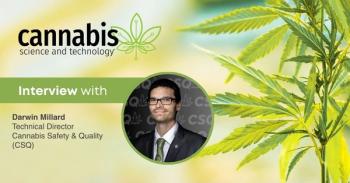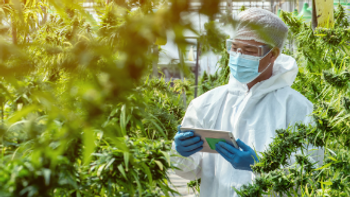
Cannabis Science and Technology
- April 2021
- Volume 4
- Issue 3
The Fields of Science and Technology Would Not Exist Without the Use of Buffers—Why Aren’t They Used with Cannabis Extractions?
Here, we take a closer look at buffers to see what solutions they might offer.
If the cannabis plant has evolved a complicated structure to house its complex oleoresin, is it even possible to solvent or mechanically extract a bioavailable oleoresin form for vaporization? Here, we take a closer look at buffers to see what solutions they might offer.
Buffer is defined as a thing that prevents incompatible or antagonistic things from coming into contact with or harming each other. Cannabis sp. separates its oleoresin from all other cellular components, as if simply existing along or inside of cells or exuded onto the leaf surface would be disastrous. If the cannabis plant has evolved a complicated structure to house its complex oleoresin, is it even possible to solvent or mechanically extract a bioavailable oleoresin form for vaporization? Perhaps through the use of a buffer we can protect, reject, and select without sacrificing oleoresin complexity.
In aqueous solutions, the hydrogen ion is the center of attention and needs to be quenched. In a cannabis oleoresin, CO2 can be positioned at -COOH, OH, and =O groups and protect these sticky regions. In a sense, CO2 is a buffer that gathers and protects those molecular positions that are responsible for bioactivity. Without protection, rare and complex molecules are polymerized or lost during a nonbuffered cannabis extraction process. Perhaps they are included in the final product, but remain too tangled to be individually volatilized during vaporization, which limits the flavor and effects of many extraction products.
Plant Experts Weigh In
A doctorate in plant molecular physiology is not required to participate in the cannabis industry. That being said, cannabis is a plant and as such should benefit from those with years of experience in plant biotechnology research.
I was trained as early as 1994 in techniques involving the extraction of subcellular components from plants and organisms. My first lesson involved the use of buffers to help us do our job in these matters.
According to Wikipedia, a “buffer solution (more precisely,
My dissertation required me to extract a delicate single stranded nucleic acid transcript called mRNA from the living and dying tissues of the tropical plant anthurium. mRNA are the transcripts encoded with genetic instructions being carried out at that moment in living cells, whereas DNA is the storage of those genetic instructions. These tropical plant tissues resembled plastic more than green leafy tissues and presented a huge problem during extractions. They were heavily imbued with exotic carbohydrates and phenolic substances that protected the plant in moist tropical environments where pathogens can thrive.
To extract mRNA, I first tried commercially available kits with little success. During one of these trials with the branded RNA extraction buffer “Trizol,” I obtained a slightly brown, highly viscous RNA solution. My next step was to add isopropanol to precipitate the RNA. Upon introduction of the alcohol the entire tube turned into a solid.
After spending a minute wondering how successful I was for obtaining so much RNA that it was almost solid, I realized a much different extraction had occurred. I had locked out any chance of getting mRNA because the carbohydrates and phenolics of the plant leaf had essentially formed an
irreversible polymer.
Conventional molecular biology wants to combine all extraction reagents in one solution to be applied in one event. Trizol extraction reagent is composed of phenol, guanidine thiocyanate, ammonium thiocyanate, sodium acetate, and glycerol. This reagent is to be used in conjunction with chloroform to extract plant DNA and RNA. However, this approach had to be quickly abandoned on tropical plant tissues.
What I discovered is that exposure of complex plant substances to a complex chemical cocktail resulted in unavoidable polymerization of all substances involved. The technique to properly extract the entire composition of recalcitrant plant tissues was to parse the chemistry out into steps. Remove the offending substances in a tiered approach, while protecting the molecules of interest. Instead of all extractions in a single solution, they must be separated out.
First, grind the plant, put in a protective aqueous buffer containing a specific molecular weight of polyvinylpolypyrrolidone (PVPP), and extract with chloroform. Then reconstitute in the buffer, then with phenol, in buffer, then with a low sugar and alcohol solution to precipitate only carbohydrates. Follow this with a wash and precipitation of nucleic acids.
In most cases, a blunt force extraction from plant material will result in some version of success (in my case the more abundant ribosomal RNA molecules), but what was lost was the complex, delicate (single stranded), and diversely unique messages of the mRNA population.
Biological Extraction
How does an aqueous nucleic acid extraction from living plant tissues have any relationship with oleoresin extraction from cannabis trichomes? In a way, identically.
In 1966, Norman E. Good penned a publication in Biochemistry introducing hydrogen ion buffers for biological research (9). He wrote: “The inadequacy of our inventory of buffers may be a more serious problem than we realize. It is impossible even to guess how many exploratory experiments have failed, how many processes have been distorted because of the imperfections of the buffers employed.”
One can only guess what Good would say today if someone told him that a diverse set of plant secondary metabolites were being isolated from its cellular environment without any concern for a buffering mechanism, and that the resulting compounds were being used to conduct medical efficacy experiments.
In the context of biological extraction for study, buffers are pervasively used to protect, isolate, and preserve molecules of interest. Buffers influence every aspect of inspection, construction, evaluation, and production of discovery (academic) and applied (commercial) biology.
Why not cannabis oleoresin? Perhaps because cannabis oleoresin is thought of as either an oil or a juice.
Oils do not need buffers for extraction and they come in “virgin” or purified, both of which do not require additional components for extraction. Purified versions are shelf stable without adulterants or preservatives. However, oils are typically one or a few types of medium-to-long chain length fatty acids. This very specific class of lipids make up what are conventionally known as vegetable oils. These substances meet the true definition of the word oil. Cannabis is classified as an oleoresin because it contains a complex mixture of substances.
Juices from fruits and vegetables also don’t require buffers, more-or-less come as described, and are frozen or stored in the same manner.
The Cannabis Trichome
This premise most aptly describes the solventless technique of concentrating trichome bulbs from cannabis plants. Whether living or cured plants, trichome bulbs are considered a concentration like juice, and the rosin created would be considered a virgin oil, perhaps one with more biological debris.
These substances (hash, rosin) are more closely related to cannabis flowers in complexity but still suffer from spoilage, in that the matrix will decay and polymerize once outside of the biological structure (trichome) in which it was designed to exist. Additionally, they are finished maturing upon extraction from the living tissue and begin the process of decay precisely when the trichome bulb is sheared at the disc cell and removed from the stalk. An intact trichome bulb attached to its stalk is protected from degradation and oxidation, an evolutionary design of the cannabis plant. Once the bulb is removed from the stalk, it suffers greatly.
Once we approach solvent extraction, we begin to discuss the idea of a buffer to protect the oleoresin molecules of the glandular trichome.
The trichome is one of the universe’s most amazing structures. The oleoresin which the trichome contains is so delicate and toxic to the cells that it must be isolated and allowed to collect and accumulate over the course of a plant’s life cycle. Cannabis sp. have evolved specialty trichomes: the bulbous, the capitate sessile, and the capitate stalked. In designing an extraction, we focus on the substances contained within these physiological structures, as they contain meaningful medicinal compounds found nowhere else in nature.
Inside this trichome, in a sea of oleoresin, float membranes that have sloughed off the endoplasmic reticulum of the trichome disc cells and contain within them membrane-bound enzymes, which catalyze the many reactions that make cannabis oleoresin molecules so complex.
Monoterpenes, the C10H16 molecules known for the characteristic perfume of living cannabis, actually are the matrix in which the trichome oleoresin conducts all its metabolism. In a nonaqueous environment, there needs to be movement of biology for molecules to come into contact with the floating membrane-bound enzymes and the substrates they require for synthesis. The disc cells continually produce monoterpenes and cell wall debris that push towards the trichome cuticle and increase and expand its size.
Once a living cannabis plant is cut, dried, and cured, the over abundance of monoterpenes volitalizes away. It then reduces the trichome bulb into more concentrated substrates that come into closer contact with their catalyzing enzymes.
This is the essence of why the curing of the cannabis plant results in more complex and flavorful resins. It is due, in part, to the reduction of monoterpenes serving as the metabolic lubricant in the trichome, and the concentration of substrates and enzymes.This is why solvent extraction of oleoresin from cannabis is so critically important.
Solvent Extraction
A solvent extraction is designed to shuttle desired compounds away from unwanted compounds of biology. In a sense, if we are able to remove biology that contributes to making cannabis extracts age poorly, then these products have an indefinite stable shelf-life. If we remove elements that corrupt and polymerize the extract, then it will indefinitely remain in good consistency for use and long term storage.
Two critically important aspects of solvent extraction are the separation of wanted and unwanted compounds and protection of the substrate being extracted.
In biology, the extraction and preparation of proteins is performed very carefully to preserve the intact protein including its three-dimensional (3D) conformation. This is similar for other substances as well. The conformation of the molecule as well as its purity is important. Do oleoresin molecules have 3D conformation? In oleoresin molecules, do we have to worry about destabilizing and presenting them as something other than how they existed in planta?
The addition of CO2 into oleoresin prior to extraction creates a buffer similar to a protective sheath, which cloaks active sites of rare oleoresin compounds. A buffer as described, CO2 can be acidic itself and the portions of the oleoresin molecules by which it attaches are the acidic portions of the molecules.
However, because of the use of nonaqueous substrates and hydrocarbon solvents, the term buffer is more aptly substituted with the term “cosolvent.”
“In chemistry, cosolvents are substances added to a primary solvent in small amounts to increase the solubility of a poorly-soluble compound. Their use is most prevalent in chemical and biological research relating to pharmaceuticals and food science, where alcohols are frequently used as cosolvents in water (often less than 5% by volume) to dissolve hydrophobic molecules during extraction, screening, and formulation” (10–15).
CO2 acts as both a buffer and a cosolvent in our extraction process because it is an extraction solvent, but it represents a very small amount compared to the hydrocarbons (butane and propane) used for extraction. In the example shown in Figure 1 from Franeker and colleagues, the molecules shown above in red would be either oleoresin contents or leaf surface waxes. These molecules, if left unprotected, would prefer to be permanently bonded to each other. CO2 helps eliminate that outcome.
CO2 bonds to active sites on all molecules and allows for effective in situ hydrocarbon separations such as avoiding unwanted substances during extraction while capturing very discrete and low-yield desirable substances. During the extraction process, due to CO2 molecular stabilization, the oleoresin compounds are not lost into or around the plant material being processed. CO2 does not covalently (permanently) bind to molecules or change their structure in any way. It uses a combination of loose chemical reactions like hydrogen bonding or Lewis Base-Acid interactions to do its job, which is quite capable and 100% reversible (see Figure 2).
Post Extraction Steps
After extraction, but remaining in the primary extraction solvent, the extract can be manipulated and split into an extract containing some whole plant impurities, and an extract free from these compounds. This is a planned event of ratioed chemistry based on the oleoresin composition carried out in the primary extraction solvent through the use of cold temperature and gravity.
Post extraction, the hydrocarbon solvent must be removed. During this event, the CO2 and the oleoresin molecules to which they’re attached, form a type of reversible polymer that prefers to remain together than spill apart. The bonded oleoresin wishes to stay together and the noncharged butane propane is easily removed down to an appropriate concentration.
After the solvent is mostly removed, the oleoresin extract is placed in an incubator where it is hard capped. The CO2 desires to release itself as the chemistry has been reduced to a point where it favors its release. The pressure that builds from this CO2 release helps produce a cascade effect where the more pressure that builds, the more CO2 is released. This event happens alongside a small amount of remaining butane and water vapor, which is also released.
Eventually butane and H2O are completely released, in that the extract finds a sort of equilibrium with its remaining CO2. It will continue to release CO2 during the course of it’s maturation and aging. This will improve or subtly change flavor and effect. Upon vaporization, these products will spontaneously release CO2 such as the decarboxylation event of tetrahydrocannabinolic acid (THCA) to tetrahydrocannabinol (THC) during its vaporization.
The CO2 is not in sufficient enough volume to be noticeable or apparent to the individual consuming the extract, no more than consuming THCA crystals. Because of this action and the presentation of discrete oleoresin molecules during vaporization, the product is able to be effectively vaporized at far lower temperatures than other available cannabis extractions and concentrates.
Because CO2 continues to buffer and protect the cannabis oleoresin during maturation and in retail packaging, the product stays slick and runny, and is able to be placed in small vials and easily dispensed upon use. Alongside THCA crystalline, it also remains slick and very easily dabbable and easy to recover the last remains of the product without difficulty. It performs flawlessly in cartridges because goop does not build up on the cartridge coil allowing the product to remain tasting like the first few draws all the way to its finish.
Whether it be a buffer or a cosolvent, CO2 is absolutely critical to protecting cannabis oleoresin molecules during extraction. It is natively apparent as most phytocannabinoids have CO2 (as COOH) already affixed in planta and require heat or age to decarboxylate these compounds and reveal, as is the case with THCA, the more active and medical version of the molecule.
It is only reasonable to conclude that the inclusion of COOH during cannabinoid phytosynthesis somehow protects or helps accumulate and store cannabinoids and other rare cannabis oleoresin bound molecules. By imbuing oleoresins with CO2 prior to extraction, the protectionary mechanism of the carboxyl group -COOH can be mimicked universally throughout the entire resin, and prepare it for extraction and presentation as an elegant and complex completely bioavailable natural plant substance ready for vaporization.
It is important to conclude with the fact that CO2, butane, and propane are simple molecules and can be added and removed from oleoresins and remain in concert with the native oleoresin chemistry. The ultimate goal is always to extract cannabis oleoresin completely without breaking it apart and reformulating it later, and to do so without exotic solvents or chemicals due to the fact that cannabis is a natural plant product and is consumed by humans with that intent.
References
https://en.wikipedia.org/wiki/PH .https://en.wikipedia.org/wiki/Hydrogen_ion .https://en.wikipedia.org/wiki/Aqueous_solution .https://en.wikipedia.org/wiki/Mixture .https://en.wikipedia.org/wiki/Acid_strength#Weak_acids .https://en.wikipedia.org/wiki/Conjugate_acid .https://en.wikipedia.org/wiki/Acid_strength#Strong_acids .https://en.wikipedia.org/wiki/Base_(chemistry)#Strong_bases .- N.E. Good, Biochemistry 5(2), 467–477 (1966).
- J. Shi, Functional Food Ingredients and Nutraceuticals: Processing Technologies, 1st ed. (CRC Press: Boca Raton, Florida, 2007).
https://en.wikipedia.org/wiki/Solvent .https://en.wikipedia.org/wiki/Solubility .https://en.wikipedia.org/wiki/Chemical_compound .https://en.wikipedia.org/wiki/Medication .https://en.wikipedia.org/wiki/Alcohol .- J.J. van Franeker, M. Turbiez, W. Li, M.M. Wienk, and R.A.J. Janssen, Nature Communications 6, 6229. Bibcode:2015NatCo...6.6229V. doi:10.1038/ncomms7229. PMID 25656313 (2015).
- C. Pettinari and A. Tombesi, MRS Energy & Sustainability 7, 1–43 (2020).
About the Author
DANIEL MAIDA HAYDEN, PhD, is the Chief Scientific Officer for Extractioneering and Inventor of HTFSE. Direct correspondence to:
How to Cite this Article
D. Hayden, Cannabis Science and Technology 4(3), 40-43 (2021).
Articles in this issue
over 4 years ago
Why Dispensaries Need In-House Testingover 4 years ago
The Evolution of Ethanol Extraction Methods in Cannabisover 4 years ago
Gaining Deep Knowledge About Cannabis Cultivation: How and WhyNewsletter
Unlock the latest breakthroughs in cannabis science—subscribe now to get expert insights, research, and industry updates delivered to your inbox.



